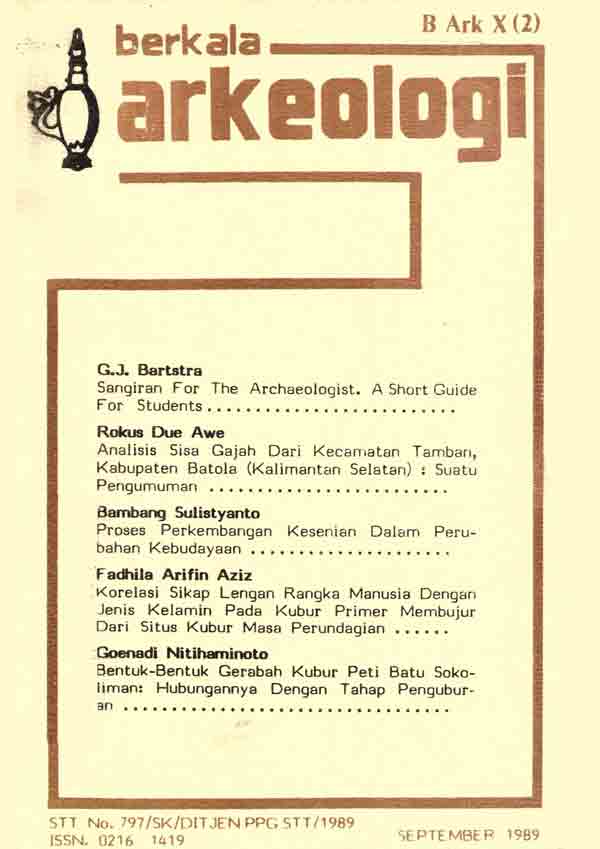SANGIRAN FOR THE ARCHAEOLOGIST A SHORT GUIDE FOR STUDENTS
Main Article Content
Abstract
To-day the most important locality of Pleistocene hominids in Southeast Asia is Sangiran. This is where Homo erectus fossils come from, to which species the famous Pithecanthropus and Meganthropus belong. Geographically or physiograplhically the area of Sangiran can be described as a basin surrounded by hills, of which the highest summits lie c1bout 180 m above sea level. From a geological point O'f view, however, Sangiran is a dome, where different deposits have been pushed upwards. As a result of subsequent erosion splendid stratigraphic sections are to be found, where Pleistocene and older deposits are exposed.
Article Details

This work is licensed under a Creative Commons Attribution-NonCommercial-ShareAlike 4.0 International License.
References
Bartstra, G.-J., 1985. Sangiran, the stone implements of Ngebung, and the Paleolithic of Java. Mod. Quat. Research in SeAsia 9, pp. 99-113.
Bartstra, G.-J., 1988. The age of Solo man and Java man. In: John R. Prescott (ed.), Early Man in the Southern Hemisphere, suppl. to Archaeometry: Australasian studies 1988: Adelaide, pp. 12-22.
Bartstra, G.-J., S. Soegondho & A. van der Wijk, 1988. Ngandong man: age and artifacts. Journ. of Hum. Evolution 17, pp. 325-337.
Bartstra, G.-J. & Basoeki, 1989. Recent work on the Pleistocene and the Palaeolithic of Java. Current Anthropology, 30, 2, pp. 241-244.
Bellwood, P., 1985. Prehistory of the Indo-Malaysian Archipelago. Sydney.
Bemmelen, R. W. van, 1949. The geology of Indonesia. The Hague.
Butzer, K.W., 1976. Geomorphology from the earth. New York.
Day, M.H., 1986. Guide to fossil man. 4th ed. London.
Dubois, E., 1894. Pithecanthropus erectus. Eine menschenahnliche Uebergangsform aus Java. Batavia.
Duyfjes, J., 1936. Zur Geologie und Stratigraphie des Kendenggebietes zwischen Trinil und Soerabaja (Java). De Ingenieur in Ned. - Indie, Mijnb. & Geologie, de Mijningenieur 3(4), pp. 136-149.
Es, L.J.C. van, 1931. The age of Pithecanthropus. The Hague.
Heekeren, H.R. van, 1972. The stone age of Indonesia. 2nd ed. (=Verhand. Kon. Instituut v. Taal-, Landen Volkenkunde 61). The Hague.
Itihara, M., Sudijono, Wikarno, & D. Kadar, 1985a. Mud volcanoes in the Sangiran dome. In: N. Watanabe & D. Kadar (eds.), Quartemary geology of the hominid fossil bearing formations in Java: pp. 117-124. Bandung.
Itihara, M., D. Kadar, N. Watanabe, 1985b. Concluding remarks. In: N. Watanabe & D. Kadar (eds.), Quaternary geology of the hominid fossil bearing formations in Java: pp. 367 - 378. Bandung.
Itihara, M., Sudijono, D. Kadar, T. Shibasaki, H. Kumai, S. Yoshikawa, F. Aziz, T .Soeradi, Wikarno, A.P. Kadar, F. Hasibuan & Y. Kagemori, 1985 c. Geology and stratigraphy of the Sangiran area. In : N. Watanabe & D. Kadar (eds.), Quaternary geology of the hominid fossil bearing formations in Java : pp. 11 - 43. Bandung.
Koenigswald, G.H.R. van, 1936. Uber altpalaolitische Artefakte van Java. Tijdschr. Kon. Ned. Aardrijksk. Genootschap 2e s. 5 3, pp. 41--44.
Koenigswald, G.H.R. van, 1939. Das Pleistocan Javas. Quarter 2, pp. 28-53.
Koenigswald, G.H.R. van, 1940. Neue Pithecanthropus Funde 1936-1938. (=Wet. Med. Dienst v.d. Mijnbouw in Ned.-Indie 28). Batavia.
Koenigswald, G.H.R. van & A.K. Ghosh, 1973 . Stone implements from the Trinil beds of Sangiran, Central Java. Proc. Kon. Ned. Akadem. v. Wetensch. 76(1), pp. 1-34.
Movius, H.L., 1944. Early man and Pleistocene stratigraphy in southern and eastern Asia (=Pap. Peabody Mus. of American Archaeol. and Ethnol. 19(3)). Cambridge, Mass.
Puech, P.F., 1983. Tooth wear, diet, and the artifacts of Java rnan.Current Anthropology 24, pp. 381-382.
Sartono, S., 1964. Stratigraphy and sedimentation of the easternmost part of Gunung Sewu (East Djawa) (=Publ. Teknik Seri Geol. Umum 1 ). Bandung.
Sartono, S., 1982. Sagittal cresting in Meganthropus palaeojavanicus Von Koenigswald. Mod. Quat. Research in SeAsia 7, pp. 201-210.
Sartono, S., 1984. Notes on the Pleistocene stratigraphy of Java. Mod. Quat. Research in SeAsia 8, pp. 129-135.
Semah, F., 1982. Pliocene and Pleistocene geomagnetic reversals recorded in the Gemolong and Sangiran domes (Central Java). Mod. Quat. Research in SeAsia 7, pp. 151-164.
Semah, F., 1986. Le peuplement ancien de Java: ebauche d'un cadre chronologique. L'Anthropologie 90(3), pp. 359-400.
Suzuki, M., Wikarno, Budisantoso, I. Saefudin & M. ltihara, 1985. Fission track ages of pumice tuff, tuff layers and javites of hominid fossil bearing formations in Sangiran area, Central Java. In: N. Watanabe & D. Kadar (eds.), Quaternary geology of the hominid fossil bearing formations in Java: pp. 309-35 7. Bandung.
Terra, H. de, 1943. Pleistocene geology and early man in Java. Trans. Am. Phil. Soc. n.s. 32, pp. 271- 339.

